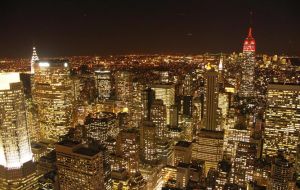MercoPress. South Atlantic News Agency
New York skyscrapers “lights-out” project to protect migratory
 The Apple landscape at night, a trap for migrating birds
The Apple landscape at night, a trap for migrating birds A growing number of New York sky-scrapers are switching off their lights to help reduce the number of birds hitting the high-rise buildings. The “lights out” project - organised by NYC Audubon - runs until 1 November, when migratory birds are expected to have completed their autumn migrations.
The Empire State and Chrysler buildings are among those dimming their lights.
An estimated 90,000 birds each year are killed in the city as a result of striking glass-fronted buildings. Organisers of the annual initiative, now in its fifth year, say the bright lights disorientate the migrating birds and override their natural navigational cues.
NYC Audubon - a group that works to protect wild birds and their habitats within the city - is calling on owners and tenants in high-rise buildings to turn off lights on unoccupied floors or unused space between midnight and dawn.
It is also asking late workers to drawn blinds or use desk lamps rather than using ceiling-mounted lighting.
A similar project in Toronto, Canada, suggests that “across North America, more birds die from collisions each year than succumbed to the Exxon Valdez oil spill”, which claimed the lives of in excess of 250,000 birds.
NYC Audubon also quotes the findings of a study at Chicago's Field Museum, which showed the number of birds killed by striking the building at night fell by 83% when the lights were switched off at night.
During the migration season, about 30 volunteers will be patrolling a number of buildings at night.
“The monitoring and research improves our understanding of the causes behind urban bird [strikes], and studies ways to prevent future [strikes] from occurring,” explained Susan Elbin, director of conservation for NYC Audubon.
Among the species that appear to be particularly affected are white-throated sparrows, common yellow throats and ovenbirds, figures suggest.
Although there is no direct evidence, anecdotal evidence seems to suggest that at night - especially in foggy or rainy weather - birds fly at lower altitudes, leaving them more vulnerable to flying into well-lit, glass-fronted high buildings.
“We don't know the true scope of the problem,” said Glen Phillips, NYC Audubon's executive director.
“Birds fall on to high floors; their bodies never reach the ground. Plus, predators, wind currents, traffic, all make it hard for us to collect and monitor deaths”.




Top Comments
Disclaimer & comment rulesCommenting for this story is now closed.
If you have a Facebook account, become a fan and comment on our Facebook Page!